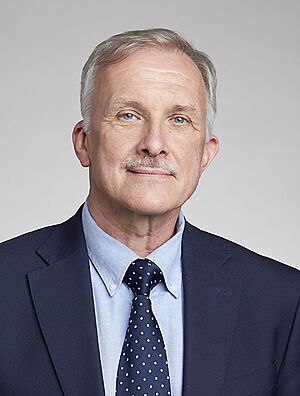J. Roy Taylor facts for kids
Quick facts for kids
J. Roy Taylor
FRS FREng
|
|
|---|---|

Taylor in 2017
|
|
| Born |
James Roy Taylor
29 April 1949 |
| Alma mater | Queen's University Belfast |
| Awards | Young Medal and Prize (2007) Royal Society Rumford Medal (2012) IoP Michael Faraday Medal (2019) FRS (2017) FREng (2022) |
| Scientific career | |
| Fields | Photonics |
| Institutions | Imperial College London Technical University of Munich |
| Thesis | Studies of Tunable Picosecond Laser Pulses and Nonlinear Interactions (1974) |
| Doctoral advisor | Daniel Joseph Bradley |
James Roy Taylor, born in 1949, is a famous English physicist. He is a professor at Imperial College London, where he studies 'ultrafast physics and technology'. This field looks at very fast events, often using special lasers.
Contents
Becoming a Scientist
Professor Taylor studied at Queen's University Belfast. He earned a degree in physics in 1971. Later, in 1974, he completed his PhD in laser physics. His research was guided by Daniel Joseph Bradley.
What He Researches
Professor Taylor is well-known for his important work with laser systems. He has helped create and improve many different types of lasers. He also finds new ways to use them in science.
Lasers and Light
He has made big steps forward in developing special lasers. These include picosecond and femtosecond dye lasers. These names refer to incredibly short bursts of light. A picosecond is one trillionth of a second. A femtosecond is even faster, one quadrillionth of a second!
He also worked on smaller, more efficient lasers. These are called diode-laser and fibre-laser-pumped lasers. They are used for many basic studies. For example, they help scientists understand how light energy moves. They also show how biological materials react to light.
Supercontinuum Light
Professor Taylor is especially famous for his studies of ultrafast nonlinear optics in fibres. This involves how very strong light pulses behave in thin glass fibres. He looked at things like solitons, which are light waves that keep their shape. He also studied how light can be made stronger.
He helped create powerful supercontinuum sources. These are also known as "white light" sources. They produce light that covers a very wide range of colours. Imagine a rainbow of light coming from one source! These sources have been very successful in science and business.
Awards and Recognition
Professor Taylor's amazing work has earned him many awards.
- In 1990, he received the Ernst Abbe Award.
- The Institute of Physics (IOP) gave him the Young Medal and Prize in 2007.
- In 2012, he was awarded the Rumford Medal by the Royal Society.
- He received the Faraday Medal and Prize from the Institute of Physics in 2019.
He was also chosen as a Fellow of the Royal Society (FRS) in 2017. This is a very high honour for scientists in the UK. In 2022, he became a Fellow of the Royal Academy of Engineering (FREng).
Images for kids


